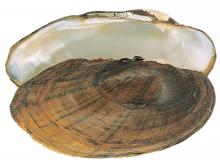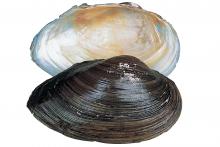Aquatic Invertebrates
Media

Species Types
Scientific Name
Lampsilis siliquoidea
Description
The fatmucket was a favorite species harvested for the button industry in the early 1900s.
Media

Species Types
Scientific Name
Pygandon grandis
Description
When a floater dies, this large mussel with a thick shell will actually rise to the water surface and float as it decays.
Media

Species Types
Scientific Name
Quadrula quadrula
Description
The mapleleaf spawns in the summer, using catfish as a host.
Media

Species Types
Scientific Name
Tritogonia verrucosa
Description
Shaped like a checkered gunstock, with its unique, turned-down edge, pistolgrips are easy to identify.
Media

Species Types
Scientific Name
Ligumia subrostrata
Description
This widespread species is one of the few Missouri mussels successful in shallow ponds and lakes.
Media

Species Types
Scientific Name
Lasmigona complanata
Description
The shell of this mollusk is large and impressive in overall size. Although fairly flat, it can be more than 8 inches long. A large wing on the heelsplitter can be painful if you step on it.
Media

Species Types
Scientific Name
Bivalve molluscs in order Unionoida
Description
Secretive and seldom seen, freshwater mussels are extraordinarily diverse in Missouri. We have nearly 70 species within our borders. Many are declining, and several are endangered.
Media

Species Types
Scientific Name
Dugesia, Planaria, and other genera
Description
Unlike their parasitic cousins in the flatworm group, turbellarians, or planarians, are tiny carnivores or detritus-eaters that glide smoothly across submerged leaves and other objects.
See Also
About Aquatic Invertebrates in Missouri
Missouri's streams, lakes, and other aquatic habitats hold thousands of kinds of invertebrates — worms, freshwater mussels, snails, crayfish, insects, and other animals without backbones. These creatures are vital links in the aquatic food chain, and their presence and numbers tell us a lot about water quality.





















